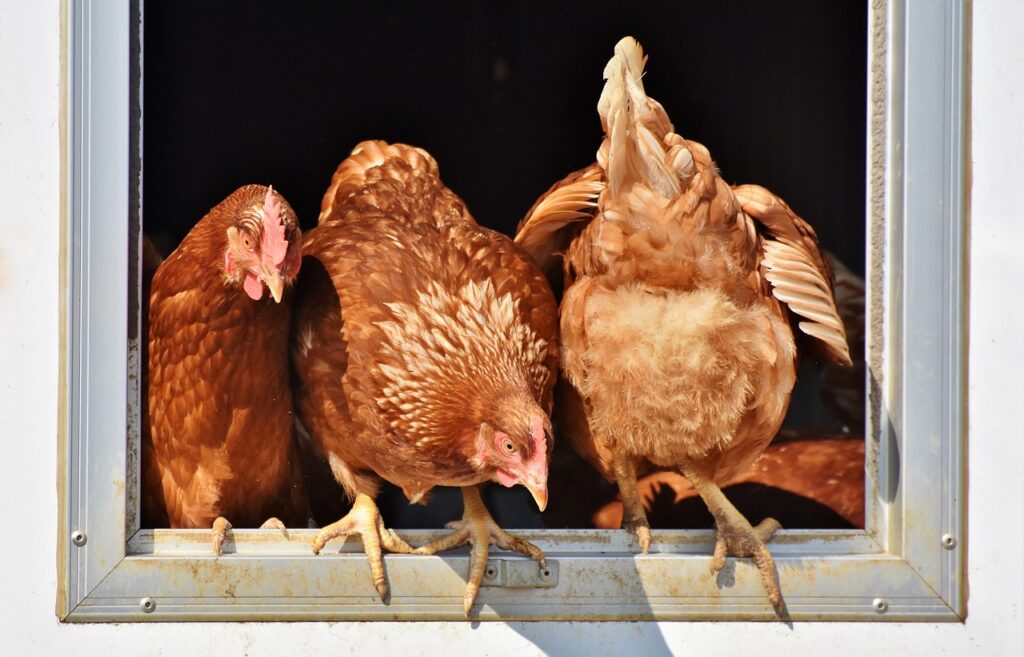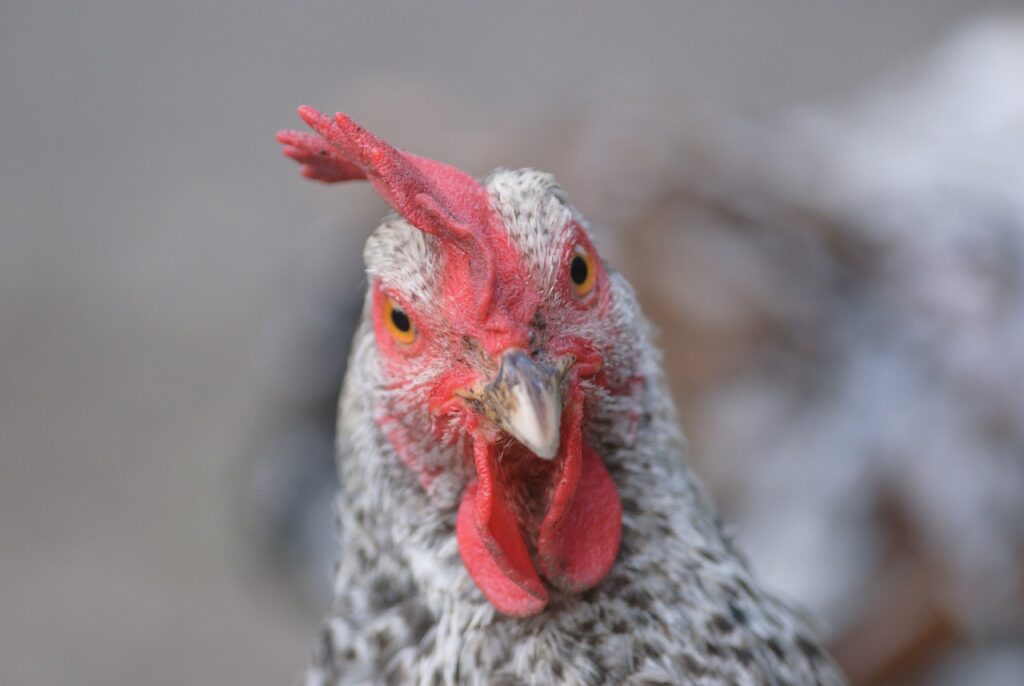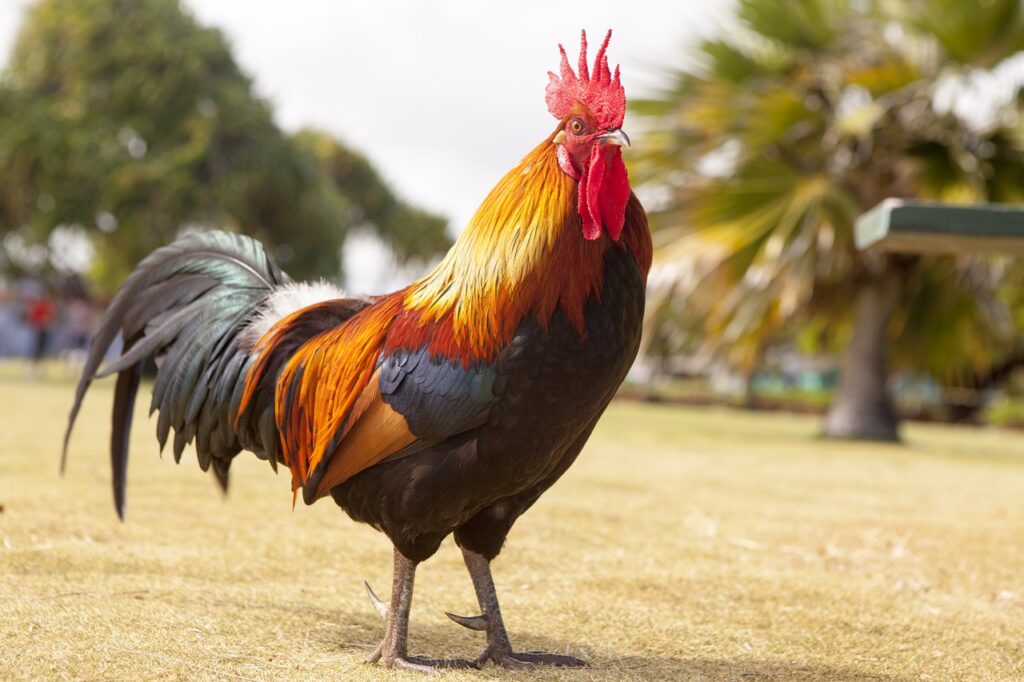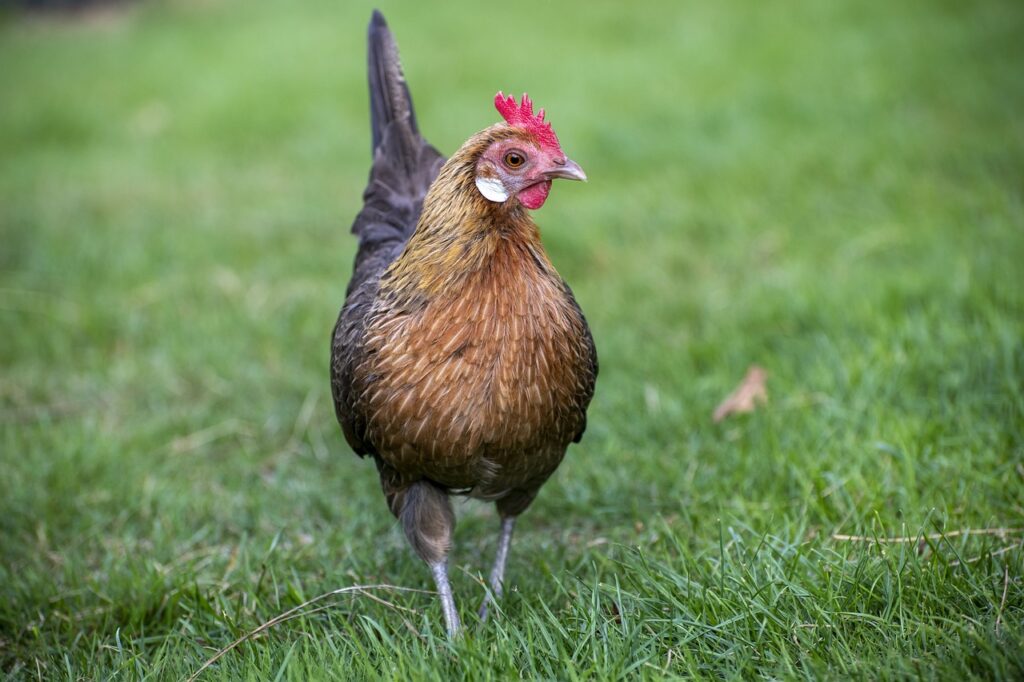In general, taking care of chickens on a homestead involves food, water, dry shelter, and egg collecting. However, raising chickens at various stages of life will require more care. In this article, we will go into how to care for chickens at different life stages, from chick, to hen, to death.
First Step: Buy or Build a Coop
Before purchasing chickens and taking them home, you need to have a chicken coop in place. Due to their high predation, a coop is required to house chickens, especially at night. Coops cost a fair amount of money, $100 to $1000 depending on size.
In general, chickens need at least 3 to 5 square feet per chicken in a coop. However, access to the outdoors will benefit the birds by allowing fresh air and foraging. On a small homestead with six grown chickens, a coop that is 3ft by 6ft for a total of 18 square feet would be sufficient. Keep in mind that more space is not harmful to chickens as long as they are protected from predators.
Early Life: Chicks

How Do I Get Good Quality Chicks?
In general, to get good quality chicks, source chickens from hatcheries that sell strains of heritage chicken breeds. The breed strains may not be purebred but aim for places that hold the breed standard with the American Poultry Association. You can read their accepted breeds and varieties here. https://amerpoultryassn.com/accepted-breeds-varieties/
What Do I Do with Chicks After I Pick Them Up from the Store?
After pickup, chicks should be taken out of the cardboard box and placed in a brooder. A brooder should be set up prior to getting your chicks home. Brooders are generally a plastic tub or trough that has dry pine shavings lining the bottom, and a heat source above. Heat lamps are the most common heat source in brooders, however a heating plate may be used as well.
For a small batch of chicks, use a small plastic tub with about 3 inches of dry pine shavings as bedding (straw may be used as well). Add a small chick feeder and waterer and keep both filled at all times. The waterer should have marbles or small rocks placed in the drinking area to prevent drowning. Chicks are notorious for being careless around water and drowning.
Chicks Need Different Heat Settings Based on Age
After you get your chicks set up in the brooder, know that chicks must be kept at a certain temperature or they will freeze, overheat, or die. Do not be alarmed if a couple of your new chicks do not make it. When watching your chicks, you will be able to tell if they are too hot or too cold. Chicks huddled together tightly under a heat source means they are too cold. Chicks hiding from the heat source or scattered to the walls is a sign they are too hot. Heat is adjusted by moving the light away or toward the animals. Temperature should be measured inside the brooder with a thermometer or temperature gun.
Temperature should read as the following based on age:
- Week 1: 90F-95F
- Week 2: 85F-90F
- Week 3: 80F – 85F
- Week 4: 75F – 80F
- Week 5 through 7: 70F – 75F
- Week 8: 65F – 70F
- Week 9: Good for any temperature
Once a chick is fully feathered (about 8 weeks or 2 months) they are good to move to a chicken coop and out of the brooder. Make sure the coop has plenty of dry bedding for warmth (about 4 inches of bedding). When getting ready to transition your chicks to the coop, begin “hardening” them off. Hardening is accomplished by reducing the heat source or removing the heat source entirely for periods of time.
If raising chicks in a colder climate, a heat source may need to be added to the chicken coop. However, sudden drops in temperature, if the heat source fails, will kill chickens.
How to Feed Chicks
Chicks always need food readily available in the first 6 weeks of their lives. Provide a chick feed or starter feed that is 18-20% protein to help support energy and growth. After chicks are 5 to 6 weeks old, remove the food every 12 hours. For instance, place the food down in the morning and pick it up at bedtime. This method will teach the chicks when feeding time will be and to not have food at night. Once chicks reach about 10 weeks of age, switch to a grower feed or a feed that is 15 – 16% protein.
Daily Care for Chicks
Every day, make sure your chicks have clean drinking water, and a full bowl of food. In addition, monitor your birds for signs of sickness, or disease. Chicks should be fluffy with clean feathers, active but relaxed, have clear round eyes, and be standing on its legs. If chicks start to show signs of illness, contact a veterinarian, and separate the sick chicks from the remainder of the birds to prevent the spreading of sickness.
Bedding in the brooder should be changed every day or two days to prevent disease. If a chick dies, change the bedding for the entire flock.
What is Poopy Butt in Chicks?
Poopy butt, or pasty butt, is the accumulation of fecal matter or waste that stick to a chick’s vent area. Generally caused from stress, the waste needs to be removed to prevent the death of the bird. Take a warm, damp cloth, and clean the area until the poop is gone. As long as action is taken swiftly, the bird will be fine.
Majority of Life: Chickens

Requirements for a Good Chicken Coop
A good chicken coop will provide protection from predators and will be well ventilated but not drafty. The size of a chicken coop is determined based on space and number of chickens. You can reference the space needs for chickens in our article on the Benefits of Chickens on a Homestead.
A chicken coop should also have a chicken run attached to it. Chicken runs are covered spaces that allow birds to have freedom to roam outside of a coop. You want the chicken run to be covered to allow for shelter in harsh weather, and protection from aerial predators like hawks.
In addition, chicken coops will need nesting boxes. A nesting box is one square foot of space off of the ground that is filled with dry bedding (pine shavings, or straw). The nesting box is where eggs will be laid, so make sure you have easy access to this area.
After nesting boxes and chicken runs, come roosting bars. Chickens roost at night when they sleep. A roosting bar does not need to be very big, an inch or two of space will work for most birds. However, scrap wood or 2×4 planks will work as well.
Lastly, chickens should have access to a dusting area, or a dust bath. Chickens will ruffle their feathers and shake dust into them to rid themselves of mites and other debris. If chickens are free range, they will find a dusting location on their own.
Deep Litter Method for Bedding in Chicken Coop
As part of the chores that come with raising chickens, their bedding will need to changed out to prevent disease and manure build up. Most commonly, experts recommend the “deep litter method” or DLM. This method involves adding fresh “green” matter on top of used “brown” matter.
For instance, your coop has 4 inches of carbon bedding (pine shavings). Three or four times a week, add fresh carbon bedding on top of the old bedding. The DLM will create a compost like effect and keep your chicken coop from smelling. If your coop does begin to smell, add more fresh bedding.
Keep in mind this method works well but the coop will still need to be cleaned out at least twice a year to maintain a healthy living space for the birds. After cleaning out the “chicken compost” add it to your garden as fertilizer to give your vegetables and flowers an extra boost.
The DLM can also be used in the chicken run area. Instead of pine shavings, use mulch or wood chips.
Free Range Chickens
In certain areas, chickens may roam and be free-range. This simply means they are loose throughout the day to forage and peck at the ground. These birds will still return to a coop at night for safety but may lay eggs in unlikely places.
A benefit to free range chickens is they do not need food regularly since they live off the land. However, you can supplement food as needed.
How to Feed Chickens
Unlike chicks, chickens can eat much more than chicken feed. It is recommended at 18 weeks of age or about 4 months old, chickens be fed 16% Layer Feed. Layer feed has added calcium that promotes strong eggshells. However, if raising meat birds, this type of feed is not necessary. Meat birds will require a higher protein feed as well as more feed in general to have them gain weight.
Chickens also eat table scraps, old vegetables, large and tough vegetables, herbs, weeds, grains, and much more. However, there are foods that are toxic to chickens. For a complete list of foods that are toxic to chickens visit https://opensanctuary.org/things-that-are-toxic-to-chickens/.
Finally, store chicken feed in a sealed container. Chicken feed is highly desirable to mice and other rodents. Using a metal trashcan, sealable plastic tub, or even 5-gallon paint containers will work very well.
Daily Care for Chicken
Every day, make sure your chickens have clean water and food. Fresh water should be changed daily, or every two days as needed. There are multiple styles of waterers, from pan to nipple. Nipple waterers are more sanitary than pan waterers.
Food should be given on a schedule and only during the day. Food should not be left out at night, as this attracts rodents and other predators. In addition, eggs should be collected daily or every two days. There are tales of chickens eating their own eggs if they are left alone with them too long.
Chickens in Winter
When caring for chickens in the winter, especially in cold climates, egg production will decrease, and death is possible. However, most chickens do fine in winter weather if given the proper tools.
For continued production of eggs, extra light can be added to the coop. Set a timer on a light to follow normal daylight hours. On average, chickens lay eggs with 14 hours of daylight. Some farmers believe it is natural for chickens to get a break from laying eggs and therefore will not add light.
To keep chickens warm, DO NOT ADD HEAT. Sudden drops in temperature to chickens are fatal. If a heating system were to fail, the chickens exposed to the cold rush may perish. Instead, keep ventilation open to allow for a dry coop, and have plenty of dry bedding. Moisture in cold temperatures can cause frostbite to chickens, and also create respiratory issues.
For chicken runs, wrap siding with plastic if expecting snow, and allow for good airflow. Finally, get a heated waterer to prevent frozen water. Changing out water every few hours when it is freezing is not a pleasant experience. However, if your climate does not get snow regularly, a heated waterer will not be necessary.
Late Life: Old Chickens

Chickens stop laying eggs around 3 years of age. Once egg production has stopped, chickens may be slaughtered or left to die of old age. Keep in mind that old hens do not provide good meat. Their meat is tough and stringy from years of moving and hard work. Older slaughtered chickens are best used for making bone broth.
If slaughtering a chicken, yourself, it is best to do it quickly. Cutting the head off in a quick chop with a sharp, heavy blade is the quickest method. Then the feathers will need to be removed. Add the chicken to a pot of hot water (not boiling or you will cook the chicken). The hot water will loosen the feathers and make it easier to pluck. After plucking all the feathers, clean the chicken and cut as desired.
If you are not interested in slaughtering your chickens, their bodies can be buried in the garden to add back to the circle of life. Keep in mind, chickens can live up to 10 years.
Final Tips for Caring for Chickens
Designated Breeding Coops
If raising chickens for producing chicks, or you have a rooster among your flock, it is helpful to have a designated coop specifically for breeding. In general, the rooster is kept in this coop and will fertilize the eggs lain in this coop. A single rooster will take care of a flock of birds (3 to 12 birds). For getting a specific breed of chicks, a designated coop is beneficial for that specific breed.
Brooding
Some breeds will have a “broody” period where they sit on fertilized eggs until hatched. However, not all breeds are good brooders. If desiring chicks, take fertilized eggs and place in an incubator if the hens are not brooding.
If you are unsure if the eggs are fertilized, there are tests you can do. Fertilized eggs can be determined by using the “candling” method otherwise known as holding a flashlight or light under the bottom of the egg to see the yolk or lack thereof.
The Pecking Order
Like most pack animals there are alphas, betas, and so forth. Chickens have a pecking order and can create cliques depending on the number of chickens. Introducing new chickens to full grown chickens is not recommended as some may be pecked to death. If you must introduce new chickens, do so slowly in separate coops to allow birds to flee if necessary.

In some countries it is still legal to have “cock fights” or fights among roosters. Having multiple roosters in a flock is frowned upon for this reason, due to the nature of the fights.
Poisoning and Disease
Any homestead animal will have some risk of disease. When caring for chickens, pay attention to their behavior and what they eat. As mentioned before, there are poisonous plants and other items that are toxic to chickens. For instance, chemical sprays or potential sources of lead, mercury, copper sulfate, and ethylene are poisonous. In addition, some natural plants that are toxic, but chickens will not eat them unless they are starving.
Botulism is another risk to chickens. Botulism exists in dirt and/or deceased animals. Therefore remove any dead animals in a chicken coop or run. Symptoms of botulism include paralysis. Once paralysis reaches the eye lids of the chicken, where blinking no longer occurs, it is too late and the bird will die. If you notice your bird is showing symptoms of paralysis, take them to a vet to be treated.
First Aid for Injured Birds
Due to chickens pecking tendencies, some birds may be left with wounds. Other wounds may occur if birds are attacked by predators. To treat cuts and wounds, begin by cleaning the wound thoroughly. For chickens that are unruly and unable to stay still, wrap them in a towel to keep them calm.
To clean the wound:
- Flush wound with saline water (1 liter of water to 2 tsp salt)
- Sanitize with hydrogen peroxide
Bandages may be added if needed, but chickens are notorious for removing them with their beaks.
Risk and Disease to Humans
Chickens are very dirty at times. A chicken coop can become very dusty and pose a risk to those with respiratory issues or sensitivities to certain allergies. Keeping a coop clean and dry is the best defense for respiratory issues.
In addition, chickens naturally carry Salmonella in their stomachs. Therefore, after handling chicks, chickens, their eggs, bedding, or feces, it is best to WASH YOUR HANDS after handling them.

Overall, caring for chickens can be as simple as providing water, food, and fresh bedding. They are easy animals to care for and are filled with personality.
Other Articles on Chickens
What Chicken Breeds Should I Have on My Homestead?
https://boonstead.com/what-chicken-breeds-should-i-have-on-my-homestead/
What are the Benefits of Chickens on a Homestead?
https://boonstead.com/what-are-the-benefits-of-chickens-on-a-homestead/
What are the Cons of Chickens on a Homestead?
https://boonstead.com/what-are-the-cons-of-chickens-on-my-homestead/
Recent Posts
In general, to harvest your own seeds, you must choose mature, healthy plants, allow seeds to dry out, and remove the seeds when they are completely dry. However, this process will look different for...
A guide on how to store and organize seeds for your garden. Vegetables, flowers, herbs, or anything you are wanting to grow. How to Store Your Seeds Proper storage of garden seeds is essential...
